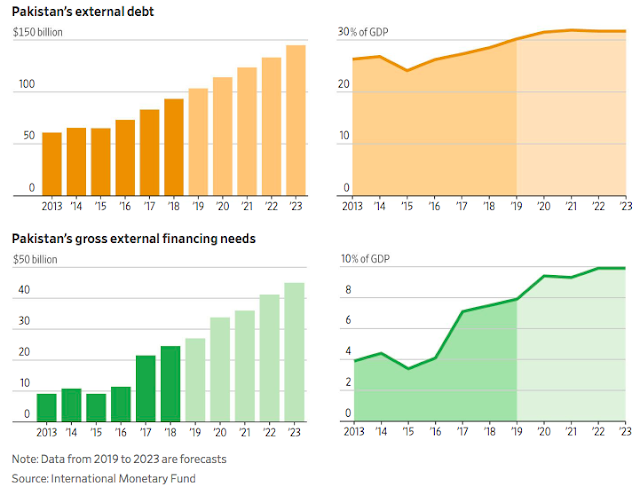PakAlumni Worldwide: The Global Social Network
The Global Social Network
PTI's New Economic Team Line-Up in Pakistan
Who are the members of Pakistan's top new economic leadership team? Who's Reza Baqir? Who's Shabbar Zaidi? Why were the changes necessary? Were the latest changes made to remove previous PMLN government's loyalists considered to be responsible for the current economic crisis? Did their policies and actions contribute to large twin deficits? Did the International Monetary Fund (IMF) force these changes as a condition for the country's bailout?
Pakistan's External Debt. Source: Wall Street Journal |
 |
| Pakistan Current Account Deficit. Source: State Bank of Pakistan |
As Pakistan awaits the news of the discovery of large offshore oil reserves, what lessons should Pakistan learn from the governance failures in Venezuela? Is Venezuela suffering because of its government's hostility toward the United States? Will large oil reserves be a panacea for Pakistan's economic problems?
Viewpoint From Overseas host Faraz Darvesh discusses these questions with Sabahat Ashraf (ifaqeer) and Riaz Haq (www.riazhaq.com)
Related Links:
Can Pakistan Avoid Recurring IMF Bailouts?
Expectation of Massive Offshore Oil Discovery in Pakistan
CPEC Financing: Is China Ripping Off Pakistan?
Information Tech Jobs Moving From India to Pakistan
Pakistan is 5th Largest Motorcycle Market
"Failed State" Pakistan Saw 22% Growth in Per Capita Income in Last...
Pakistan's $20 Billion Tourism Industry Boom
-
Comment by Riaz Haq on June 28, 2019 at 4:28pm
-
Fitch cuts growth for #Pakistan to 3.2% in FY2018/19 and 2.7% in FY19/20 with tighter monetary/fiscal policies. #CPEC will provide support to #economy. "Construction of many key CPEC projects has already started and will stretch over the coming years.” https://tribune.com.pk/story/2001719/2-fitch-chops-growth-forecast-...
Fitch Solutions, the US-based global research house, has revised down Pakistan’s economic growth forecast, believing tightening of monetary and fiscal policies under the International Monetary Fund (IMF) bailout would negatively impact GDP growth.
“We at Fitch Solutions, have revised our forecast for Pakistan’s real GDP (gross domestic product) growth for FY2018/19 (July-June) and FY19/20 to come in at 3.2% and 2.7% respectively, from 4.4% and 4.0% previously (versus the Bloomberg consensus of 3.3% and 3.5%),” the global research house said in a report on ‘Economic Analysis – IMF deal to weigh on Pakistan’s growth in the short run.’
“We believe that the bailout package from the IMF will see tighter monetary and fiscal policies in Pakistan, which will be negative for growth in the near term,” it said.
However, investment into the China-Pakistan Economic Corridor (CPEC) will continue to provide some support to the economy, it added.
After close to eight months of negotiations, Pakistan reached an agreement with the IMF in May for a $6 billion bailout package to address its balance of payment crisis. Following the agreement, the State Bank of Pakistan (SBP) increased the policy rate by 150bps.
Shortly after, the Ministry of Finance presented a budget in June with the aim of trimming Pakistan’s primary deficit to 0.6% of GDP in FY19/20, from 1.9% of GDP in FY18/19 according to the IMF’s estimates. “Given the tighter monetary and fiscal policies amid an already subdued economic growth outlook, we at Fitch Solutions have revised (down) our forecast for Pakistan’s real GDP growth,” it said.
Comment
- ‹ Previous
- 1
- 2
- Next ›
Twitter Feed
Live Traffic Feed
Sponsored Links
South Asia Investor Review
Investor Information Blog
Haq's Musings
Riaz Haq's Current Affairs Blog
Please Bookmark This Page!
Blog Posts
Clean Energy Revolution: Soaring Solar Energy Battery Storage in Pakistan
Pakistan imported an estimated 1.25 gigawatt-hours (GWh) of lithium-ion battery packs in 2024 and another 400 megawatt-hours (MWh) in the first two months of 2025, according to a research report by the Institute of Energy Economics and Financial Analysis (IEEFA). The report projects these imports to reach 8.75 gigawatt-hours (GWh) by 2030. Using …
ContinuePosted by Riaz Haq on June 14, 2025 at 10:30am — 3 Comments
Builder.AI: Yet Another Global Indian Scam?
A London-based startup builder.ai, founded by an Indian named Sachin Dev Duggal, recently filed for bankruptcy after its ‘neural network’ was discovered to be 700 Indians coding in India. The company promoted its "code-building AI" to be as easy as "ordering pizza". It was backed by nearly half a billion dollar investment by top tech investors including Microsoft. The company was valued at $1.5 billion. This is the latest among a series of global scams originating in India. …
ContinuePosted by Riaz Haq on June 8, 2025 at 4:30pm — 12 Comments
© 2025 Created by Riaz Haq.
Powered by
![]()

You need to be a member of PakAlumni Worldwide: The Global Social Network to add comments!
Join PakAlumni Worldwide: The Global Social Network